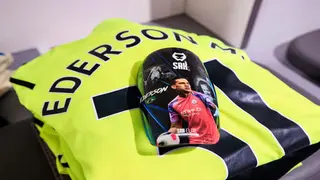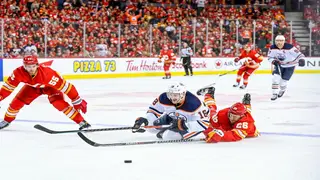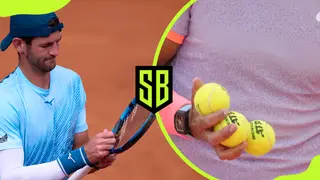Soccer equipment list: Essentials a footballer needs to have
Football
Ice hockey is a fast-paced contact sport that has existed for centuries since early civilisation. The intense contact in ice hockey games makes injury protection a crucial component of every piece of equipment worn by players. Dig in for a comprehensive ice hockey equipment list.

What equipment is needed for hockey? Sports Brief has sourced information from the 2023/2024 International Ice Hockey Federation and the National Hockey League rule books to create this authoritative list of the essential equipment required for playing ice hockey.
Sports teams typically require players to wear uniforms in team colours. Find out about ice hockey equipment, their names, pictures and uses here.
Team members are required to dress similarly in the approved squad's uniform. According to the federation's definition, the players' uniform includes helmets, jerseys, pants, and skates that match the colour and design. Here is the equipment list for ice hockey as guided by the international ice hockey governing body.
Soccer equipment list: Essentials a footballer needs to have
Football

Equipment | Uses |
Jersey | It offers player identification by team, name and number |
Pants | It offers coverage and protects the player's lower body |
Elbow pad | It protects the elbows |
Mask | It offers facial protection |
Mouthguard | It protects the teeth, gums and jaws |
Gloves | It warms the hand and improves the grip |
Helmet | It prevents head injuries |
Neck and throat protection | It protects the neck and throat from puck lacerations |
Shoulder cap and clavicle protectors | It is worn to protect the upper chest area and shoulders |
Chest and arm protectors | It protects the chest and arms |
Shin pad | It protects the shin |
Skates | It is used for movement |
Stick | It is used to hit and control the puck |
Stick tape | It adds grip and improves puck control |
Puck | It is used to score |

The jersey is one of the most crucial parts of the ice hockey equipment list. It is worn over upper body protection devices such as neck laceration protectors, shoulder caps, clavicle protectors, chest protectors, and arm protectors. It offers team and position identification for players.
A list of the best looking soccer cleats ever made: which is your favourite?
Football
In ice hockey, players’ full surname names are worn across the back of the jersey at shoulder level. The nameplate must be 10 centimetres (3.9") high and written in capital letters.

Players must pair their numbered jerseys with mid-length padded pants to complete a team's uniform. The padded pants are protective gear that covers all lower body parts except the knee, shin, and foot.
What do hockey players wear under their pants? For complete coverage, sources reveal that players can wear compression pants, leggings or hockey underwear, followed by large socks.

A British Association of Sport and Exercise Medicine study revealed that 19% of injuries in ice hockey players occurred to their upper extremities. The elbow pads must have a soft sponge rubber outer covering of at least 1.5 centimetres (0.5") thick and be fully covered by the player's jersey.
A ranked list of the 10 best football helmets for maximum safety
NFL

Head injuries are among the most common injuries in contact sports. To prevent them, all players must wear an approved helmet with a well-secured chin strap during all games and pre-game warm-ups. This applies to all players in the rink and on the players’ benches.

In ice hockey, players can use facial protection in the form of a visor, cage, or full-face visor that can be attached to the helmet. The visor and cage protect a player's face, eyes, nose and mouth.

Mouthguards are crucial in the sport. However, as players opt not to wear the device, broken teeth and smashed jaws are common in ice hockey. Other common dental injuries on the rink include torn lips, lacerated tongues and gums.

Neck and throat protectors, also known as neck laceration protectors, are highly recommended for all players, especially junior league players. For goalkeepers, the protection device should start below the chin and cover as much of the body as possible.
Ice hockey vs field hockey: Key differences and similarities
NHL

In ice hockey, gloves are considered protective equipment and should be worn under the uniform. By keeping players' hands warm, gloves allow players to keep up their performance despite the lower temperatures in the tank. Wearing gloves in which all or part of the palm has been cut or removed invites a minor penalty.

Why do ice hockey players wear shoulder pads? Body checking is common on the rink and involves direct hits from one player to another's shoulder or hip. All players, including goalkeepers, should wear shoulder caps and clavicle protectors to reduce the effect of such incidences or flying pucks.

According to the 2023/24 guidelines, goalkeepers must wear chest and arm protectors. The official ice hockey equipment list requires players to use anatomically proportional shielding devices without any observable raised ridges around the chest, arms, or shoulders.
How to play Horse Polo: What are the rules and how do you win?
Other Sports

Skaters' protective gear includes shin pads worn under the uniform. Like mouth guards, shin pads must be a custom size that fits inside each skater’s standard socks, and no protrusions are allowed. Additional leg protection devices in the ice hockey equipment list include thigh pads or thigh protectors.

Ice hockey players wear specialised footwear to aid in fast movement and quick reactions on the ice. This footwear includes a four-part skate comprising the boot, laces, blade, and holder. The blade holder takes the curvature of a skate blade and runs from the front to the back of the blade.

Players' sticks used to hit the puck are made of wood, fibreglass, carbon fibre, boron fibre, or foam cores. According to IIHF regulations, the sticks' dimensions must be up to 163 centimetres (64”) from the blade's end to the shaft's start.
NHL guidelines for the skaters’ stick differ by an inch. The blade length must also not exceed 32 centimetres (12.5”). Exceptions to these measurement requirements apply to players 200 centimetres (6’6”) tall or taller.
Soccer players with glasses: A list of players who wear glasses
Football

Why do ice hockey players tape their sticks? Adhesive tape is often wrapped around the stick at specific places, such as the handle, shaft, or blade, for reinforcement, grip, improved puck control and accuracy. According to Pure Hockey, players often use the tape on blades to protect stick blades by reducing ice buildup and preventing moisture damage.

The puck acts as the ball in football and other sports. An ice hockey game aims to keep the puck in play and drive it into the opposing team's goal, making it one of the most essential items on the ice hockey equipment list.
Based on IIHF guidelines, the disc is made of vulcanised rubber. It measures 2.5 centimetres (0.9") in thickness and 7.6 centimetres (2.9") in diameter and weighs between 156 and 170 grams.
What is a kit in soccer? What is it, and what is the need for it?
Football
A 2023 study by the National Library of Medicine revealed that between 2018 and 2022, NHL goalies suffered higher rates of injuries throughout the season than skaters in other positions. The emphasis on players' safety has played a role in the choice of devices for the goalie's kit. Have a look at this ice hockey equipment list used by goalkeepers.

Like skaters, goalkeepers' uniforms are an identification device for their names, teams, and positions because of their distinct colours, names, and numbers. Each goalkeeper's jersey and pants must be named and numbered and should fit their physical characteristics.

Goaltenders are required to wear helmets and facial masks throughout a game. Unlike skaters, the goalie's facial protection must offer full coverage, including the chin.

The goalie wears two distinct gloves, different from those worn by skaters. The blocking glove is a rectangular protective device worn on the back of the arm and forearm. It measures up to 20.5 centimetres (8") by 38.5 centimetres (15.1") and guards the goalie's thumb and wrists, allowing it to block pucks.
Discover the various tennis equipment and their functions
Tennis
According to the NHL, the catching glove or trapper is the goalie's second set of gloves. The keeper must wear one of each glove during a game.

These are padded pieces of equipment that cover the thigh and knees. The thigh pad is worn 12.7 centimetres (5") up from the bottom of the pants and extends eight to eleven inches down the leg.
Leg guards are extended padding worn by the goalie on the outside of the uniform leg. Like the uniform, the leg pads must fit each goalkeeper’s physical characteristics. Its width must not exceed eleven inches, while the NHL dictates the height requirements through the Hockey Operations Department.

According to NHL guidelines, the goaltender's stick has three distinct portions, unlike the sticks used by skaters. The shaft is divided in two and includes a widened portion, 792.5 centimetres (26”) long and a shorter, thinner portion. The blade should be 472.4 centimetres (15.5”) in length and up to 107 centimetres (3.5”) wide.
Uncover the wide range of rugby equipment and their operational roles
Rugby
The authorised ice hockey equipment list excludes colours, designs, stickers, and attachment devices such as Velcro that the league has not approved. Here are more interesting facts about the complete ice hockey equipment list. You will also understand how to use the different types of ice hockey equipment.
Before getting onto the rink, players must wear jerseys, padded hockey pants, gloves, shin pads, shoulder pads, elbow pads, helmets, and skates.
Ice hockey teams consist of 18 skaters and two goalkeepers. Before a match, all eligible skaters and at least one goalkeeper must be fully dressed.
Great emphasis is placed on safety for all ice hockey players. This is evident in the International Ice Hockey Federation and the National Hockey League's approved ice hockey equipment list.
READ ALSO: Hockey positions explained: Exploring the unique responsibilities of hockey positions
Sports Brief has published an article on all hockey positions and their roles. Hockey is played by two teams of six players, each with a goalkeeper, three forwards, and two defence players. Click on the link above for details of each position and its responsibilities in the team.